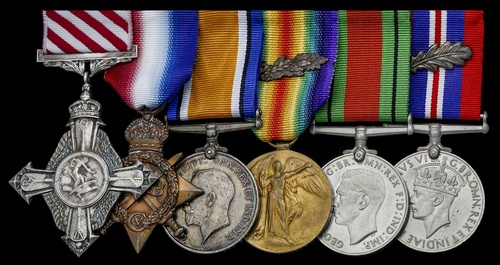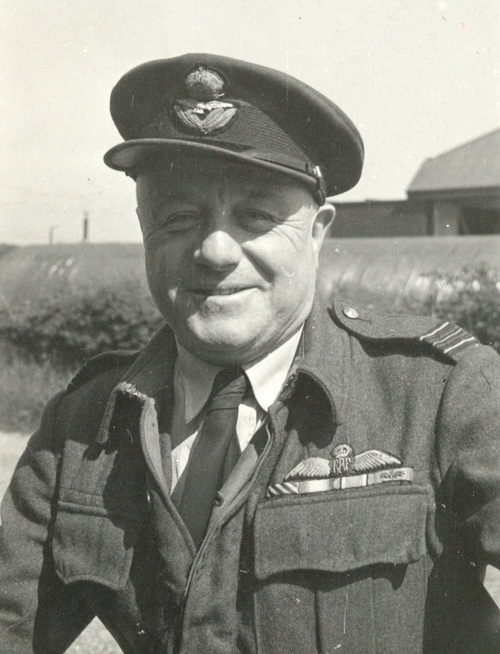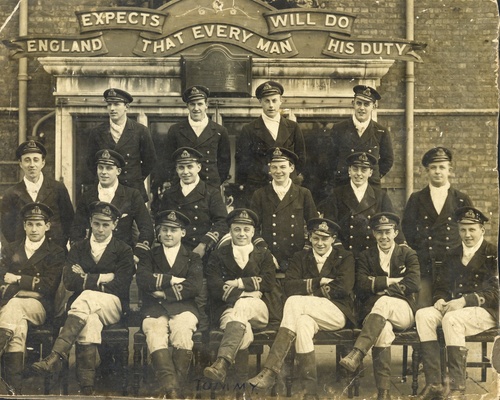Auction: 17002 - Orders, Decorations and Medals
Lot: 395
An exceptional Second World War A.F.C. group of six awarded to Squadron Leader S. R. 'Tummy' Sunnucks, Royal Air Force Volunteer Reserve
Having gone to sea as a mercantile apprentice before the Great War, he served as a Midshipman R.N.R. in destroyers and won a 'mention' for setting a very fine example to his ship's company in a daring rescue in a minefield off Le Havre in March 1917. He then transferred to the R.N. and submarines, gained the approbation of Naismith, V.C., and won second 'mention' for his part in a spectacular 'sub-on-sub' action in E. 35 under Doyly-Hughes in May 1918
Further adventures ensued between the wars, including time as skipper of 'a small boat in Central Africa' and as a 'bush pilot' in Canada, but it was for his gallantry as an R.A.F. pilot at Calshot that he came to the attention of the British public at large, his most gallant rescue of fellow seaplane aircrew one night in August 1925 hitting the headlines
As it transpired, he was back in the news in January 1944 when, on being awarded the A.F.C. for his services in Coastal Command, the Air Ministry's press agency announced that he was the oldest pilot on regular flying duty: the recommendation for the award added that he was 'suffering from a wound received in the Great War.'
Air Force Cross, G.VI.R., the reverse officially dated '1944', with its Royal Mint case of issue; 1914-15 Star (Mid. S. R. Sunnucks, R.N.R.); British War and Victory Medals, M.I.D. oak leaf (Lieut. S. R. Sunnucks, R.N.); Defence and War Medals 1939-45, M.I.D. oak leaf, together with his Great War miniature dress medals, very fine or better (9)
A.F.C. London Gazette 1 January 1944. The original recommendation states:
'This officer took over the Beam Approach Training Flight at the Station [R.A.F. Leuchars] in February 1943 and has obtained excellent results not only in training but in general efficiency and spirit of the unit [No. 1510 Flight]. Since changing over the functions of the Flight to that of A.S.V. Beam Approach training the instruction given has further improved and this has been mainly due to the lead given by Squadron Leader Sunnocks himself. Besides doing his normal duties extremely conscientiously and well he has been a great asset on the Station as Liaison Officer with the A.T.C. His efforts are all the more commendable when it is realised that he is nearly 50 years of age and suffers from a wound received in the Great War.'
Stephen Reginald Sunnucks was born in Ipswich, Suffolk on 22 September 1896. Apprenticed to the P. & O. Steamship Navigation Company in May 1912, he was similarly employed when appointed a Midshipman in the Royal Naval Reserve in November 1914. He joined the armed merchant cruiser H.M.S. Otway in the same month.
Destroyers - minefield rescue operation - M.I.D.
In July 1916, Sunnucks removed to the torpedo boat destroyer Arab at Scapa and, following a gunnery course in early 1917, to the destroyer Druid. He was about to gain his laurels for, on 10 April 1917, Druid went to the assistance of the hospital ship Salta and one of our patrol boats, both of which had been mined off Le Havre.
In a 'splendid piece of seamanship', Druid's captain got alongside the stricken patrol boat to take off survivors, and won himself a D.S.O. in the process. Two of his officers appeared on the same list of recommendations, both of whom 'set the ship's company a very fine example': one of them was Sunnucks, who was duly mentioned in despatches (London Gazette 23 May 1917, refers).
Submariner - sub-on-sub action - M.I.D.
In May 1917, Sunnucks joined the submarine branch, in which capacity he was transferred to the Royal Navy in September of the same year. His service record reveals that he quickly won the approbation of Naismith, V.C., who recommended him for special promotion. He would shortly come under the watchful eye of another famous submariner, Lieutenant Guy D'Oyly-Hughes, D.S.O., D.S.C., for he joined the latter's command - the E. 35 - in August 1917.
Nor did Sunnucks disappoint, for he won a mention in despatches for his part in E. 35's successful action against an enemy submarine on 11 May 1918. A Damned Un-English Weapon, by Edwyn Gray, takes up the story:
'The attack lasted two and a half hours and D'Oyly enjoyed a narrow escape at the end. U-154 was quartering the surface apparently waiting to rendezvous with another U-Boat when E. 35 spotted her and, due to the enemy's frequent changes of course, it took a long time to get the submarine square in the sights. D'Oyly fired two torpedoes just to make sure and both struck causing such a violent explosion that several of E. 35's light bulbs were shattered.'
D'Oyly-Hughes continues the story in his official report:
'Having examined the horizon as carefully as possible through the periscope, we came to the surface alongside debris to pick up survivors, of whom there were about three clinging to wreckage in the middle of a large calm patch. I had the Coxswain and one Able Seaman on deck with life-lines, revolvers, etc., when Sub. Lieutenant Sunnucks arrived on deck and almost at once spotted another large submarine of the more usual U-Boat type on the crest of a wave bearing 270 degrees, distant about two and half miles. I dived at once and headed for the new enemy but was unable to pick her up in the periscope.'
In concluding his report, D'Oyly-Hughes appended a list of recommendations:
'This officer [Sunnucks] has been my Navigating Officer since August 1917 and in very many ways has assisted me in maintaining E. 35 in a seaworthy condition. He it was who sighted the enemy a 4 p.m. on 11 May, being on the periscope watch at that time. It is doubtful whether the enemy would have been sighted at all but for his exceptional eyesight and careful lookout. He also sighted the second submarine when the E. 35 was about to pick up survivors from the first.'
Sunnucks was mentioned in despatches (London Gazette 14 September 1918, refers).
Hero of Calshot - official endorsement of the Air Council
Having departed the Royal Navy at the war's end, Sunnucks pursued his career in the Merchant Navy and took his Board of Trade's Master's Certificate of Competency in August 1920; accompanying sources state that 'he commanded a small ship in Central Africa and was Harbourmaster at Dar-el-Salaam.'
Those adventures concluded, he returned to the U.K. and gained a commission in the Royal Air Force. By the mid-1920s he was serving at the seaplane base at Calshot where, on 15 August 1925, he displayed great courage in rescuing fellow aircrew from a stricken seaplane. A contemporary newspaper report takes up the story:
'A dramatic story of a Flying Officer's heroic rescue of comrades from a blazing seaplane was told yesterday.
While the flying boat was returning to Calshot round about midnight it crashed into the sea. One of the petrol tanks exploded, and the boat burst into flames. There was at once a rush to the rescue from Calshot air station, where a motor boat is always on hand for emergencies.
In charge of the boat that went to the rescue was Flying Officer Stephen Sunnucks. Blazing petrol on the water presented a barrier in the way of rescue.
Flying Officer Sunnucks jumped into the water without abandoning uniform or boots, and swam to the flaming flying boat, which he boarded, and after great effort succeeded in rescuing Flight Lieutenants N. M. S. Russell and R. Collins, with whom he swam back to his boat. They were in an exhausted condition and probably would have perished but for the timely aid.
Not content with these courageous actions, Flying Officer Sunnucks, after landing the two men on his motor-boat, went back to the machine which by this time was a roaring furnace. He climbed onto the hull, but was able to remain on it for only a few seconds owing to the tremendous heat.
He therefore dived back into the water to cool himself and his clothes before returning to the machine. Eventually he had to abandon his attempt to rescue the wireless operator, Reginald F. G. Copsey, who must have been killed instantly, for he had a fractured skull, a broken neck and other injuries. Corporal H. Essam managed to jump clear in time.
The three rescued men were all burned and are in hospital. Flight Lieutenant Russell is in a serious condition.
The coroner, in recording a verdict of death by misadventure, at yesterday's inquest, said he understood Flying Officer Sunnucks, who was not present at the inquest, had displayed singular gallantry in trying to rescue the men who were in the machine when it rose to the surface after the first submerging.
He understood he swam under the water to avoid the flaming petrol. As a result of his plucky action, two of the men were saved and the other swam ashore unaided.'
The A.O.C. H.Q. Coastal Area having submitted a recommendation for due reward, the Air Council responded with a mere endorsement on Sunnucks' service record, 'in appreciation of his courage and promptitude'; an accompanying letter, refers.
The R.A.F's oldest pilot on regular duty - A.F.C.
Tiring, perhaps, of the unrewarding nature of service life, Sunnucks opted for a new life in Canada, where he was granted a private and commercial pilot's licence and flew as 'bush pilot' in the late 1920s and early 30s. He then returned to the U.K. and was appointed a civilian instructor at the School of Navigation at R.A.F. Manston in 1936.
As a result of this employment he found himself taken up by Coastal Command after the renewal of hostilities, when he lent valuable service to No. 1510 Flight as 'bad weather man' at R.A.F. Leuchars. In addition to his subsequent award of the A.F.C., he was mentioned in despatches (London Gazette 1 January 1943, refers). Sunnocks, who published Air Rule of the Road and Air Legislation, died at Camberwell in 1953.
Sold with a large quantity of original documentation, including:
(i)
The recipient's R.A.F. Pilot's Flying Log Book (Form 414 type), covering the period February 1941 to January 1945.
(ii)
Buckingham Palace A.F.C. forwarding letter, in the name of 'Squadron Leader Stephen R. Sunnucks, A.F.C.'
(iii)
M.I.D. certificate, in the name of 'Flight Lieutenant S. R. Sunnucks, Royal Air Force Volunteer Reserve, and dated 1 January 1943.
(iv)
Air Ministry letter reporting that his service record had been endorsed for his 'courage and promptitude' off Calshot, dated 28 October 1925, together with a quantity of letters and telegrams relating to the same incident, among them moving letters of gratitude from the parents of the airmen he rescued, and a quantity of related newspaper cuttings.
(v)
The recipient's Board of Trade 2nd Mate's certificate, dated 12 May 1916 and his Master's Certificate of Service, dated 13 August 1920.
(vi)
Commercial Air Pilot's Certificate (Flying Machines), as issued to the recipient in Canada, dated 1 April 1932.
(vii)
A signed copy of the recipient's book, Air Rule of the Road and Air Legislation (Nautical Press, Glasgow, 1937).
(viii)
A copy of the Onleuchar Station News Sheet, 4 July 1944, with feature on the recipient.
Additional reference sources:
Gray, Edwyn, A Damned Un-English Weapon (Seeley, Service & Co. Ltd., London)
The Onleuchar Station News Sheet, 4 July 1944.
The National Archives (T.N.A.): ADM 137/154, ADM 157/584, 171/85 and 340/132.
Subject to 20% VAT on Buyer’s Premium. For more information please view Terms and Conditions for Buyers.
Sold for
£2,500









